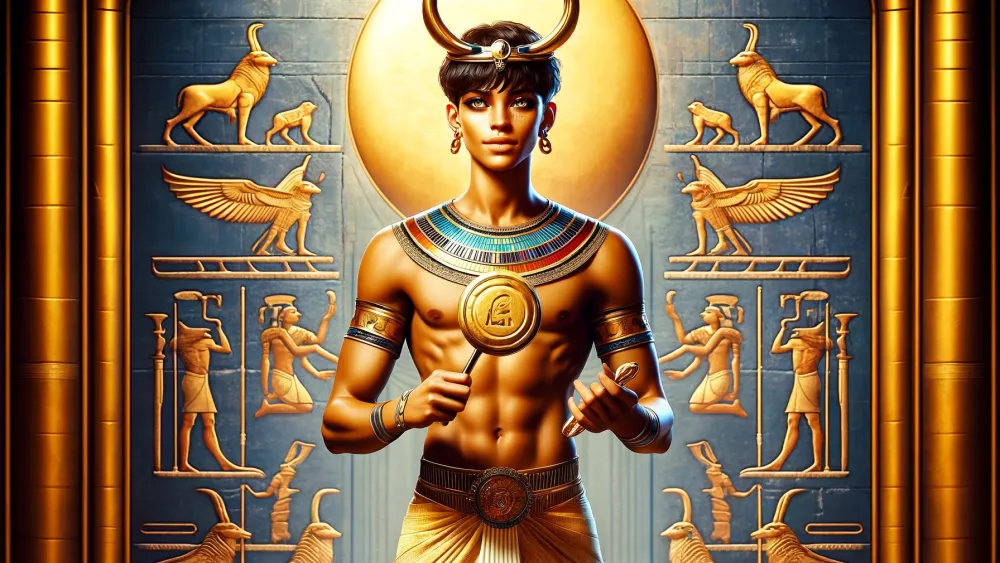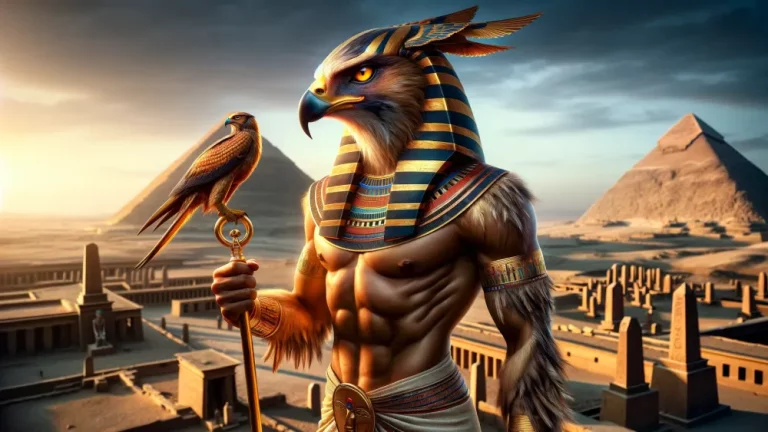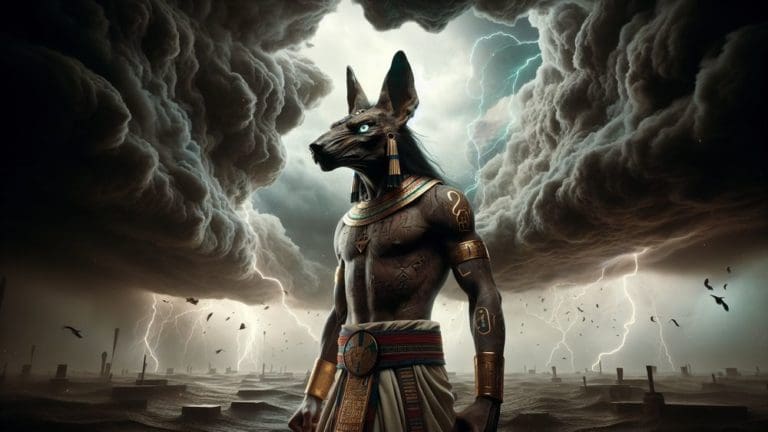Ihy: The Ancient Egyptian God Of Music And Joy
In the rich story of ancient Egyptian mythology, Ihy stands out as a special and lively god. He embodies music and joy. As the child of Hathor, the goddess of love and music, and Horus, the sky god with a falcon head, Ihy holds a special spot among gods. His story ties deeply to how people in ancient Egypt lived their spiritual lives. Music and celebration were key parts of this life.
Key Points:
- Ihy is the Ancient Egyptian god of music and joy.
- He is the child of Hathor, the goddess of love and music, and Horus, the sky god.
- Ihy plays a crucial role in rituals and celebrations, where music and joy are central.
- Ihy is often shown holding a sistrum and is linked to festivities and religious ceremonies.
- His connection to his parents, Hathor and Horus, influences his role as both joyful and protective.
- Temples dedicated to Hathor, like the one at Dendera, also honor Ihy through music and dance.
- Ihy’s symbolism includes the sistrum for joy and divine music, and he is often represented as a young child in art and literature.
This blog post dives into where Ihy comes from, what he does, and how people worship him. It shows why he matters so much in ancient Egyptian culture and his lasting joyful spirit.
Ihy: Overview and Key Facts
| Aspect | Details |
|---|---|
| Name | Ihy |
| Role | God of Music and Joy |
| Parents | Hathor (Goddess of Love and Music) and Horus (God of the Sky) |
| Symbol | Sistrum, a special musical instrument |
| Primary Attributes | Joy, music, celebration |
| Depictions | Often shown as a young boy holding a sistrum |
| Major Temples | Temple of Hathor at Dendera |
| Worship Practices | Music, dance, playing the sistrum |
| Cultural Significance | Key to religious ceremonies and festivals |
| Mythological Stories | Birth story with Hathor and Horus. Linked to joy. |
Nonetheless, his role goes beyond just being joyful. He plays an important part in rituals. For instance, people use music to honor him during celebrations. Eventually, this makes him central to many traditions.
The Origins of Ihy
To get Ihy’s story, we need to see where he comes from. Let’s explore his mythological roots and family ties.
The Mythological Origins of Ihy
Ihy’s story starts with his birth, which is special in Egyptian mythology. He comes from Hathor and Horus. Hathor, the goddess of love, music, and motherhood, plays a big role in many myths. Meanwhile, Horus is the sky god often shown with a falcon head. Together, they create a powerful lineage for Ihy. His birth story shows the union of love and protection (key elements in Egyptian beliefs).
Consequently, Ihy’s divine family background places him among the top gods. The importance of Ihy’s parents can’t be overstated. Hathor stands for joy, music, and motherly care; she is one of the most loved deities. On the flip side, Horus represents power and protection as he rules over kingship and skies.
Their union brings together two key life aspects: nurturing love and strong guardianship. This mix shapes Ihy’s role as the god of music and joy because he inherits traits from both parents – joy from Hathor and strength from Horus.
Ihy’s divine lineage from Hathor and Horus imbues him with a unique blend of traits, combining love and protection which define his role as the god of music and joy.
Ihy’s Connection to Hathor and Horus
Ihy’s bond with his divine parents, Hathor and Horus, shapes who he is. Hathor, the goddess of love, music, and motherhood, gives Ihy a joyful side. She often holds or plays the sistrum (a musical instrument), which becomes Ihy’s symbol too. This link to Hathor highlights Ihy’s role in music and joy. Meanwhile, Horus adds strength and protection to Ihy’s character because he is the sky god and protector.
Often shown as a falcon or a man with a falcon head, Horus symbolizes watchfulness. Consequently, Ihy inherits both joy from Hathor and protection from Horus, making him special. This close relationship with his parents greatly affects how people see Ihy in ancient Egypt. Since Hathor connects to music and joy, people naturally view Ihy as their god too.
Temples for Hathor often have shrines for Ihy where folks play music and dance in his honor. On the flip side, because of Horus’s protective nature, they also see Ihy as a guardian during celebrations and rituals. For instance, during festivals, people call on Ihy to ensure everything goes smoothly. This dual influence makes him well-rounded – embodying both joy plus protection – in religious practices.
Ihy’s Role in Ancient Egyptian Culture
Given that he has a special bond with Hathor and Horus, Ihy’s influence runs deep in ancient Egyptian life. Let’s see how he shapes their culture.
Ihy as the God of Music and Joy
Ihy’s main roles focus on bringing happiness and harmony. He often appears as a young boy holding a sistrum (a musical instrument) and a necklace of beads, which show his link to music and fun. In particular, Ihy oversees musical performances and makes sure celebrations are joyful. He also inspires musicians and dancers, making him key in any party or festival.
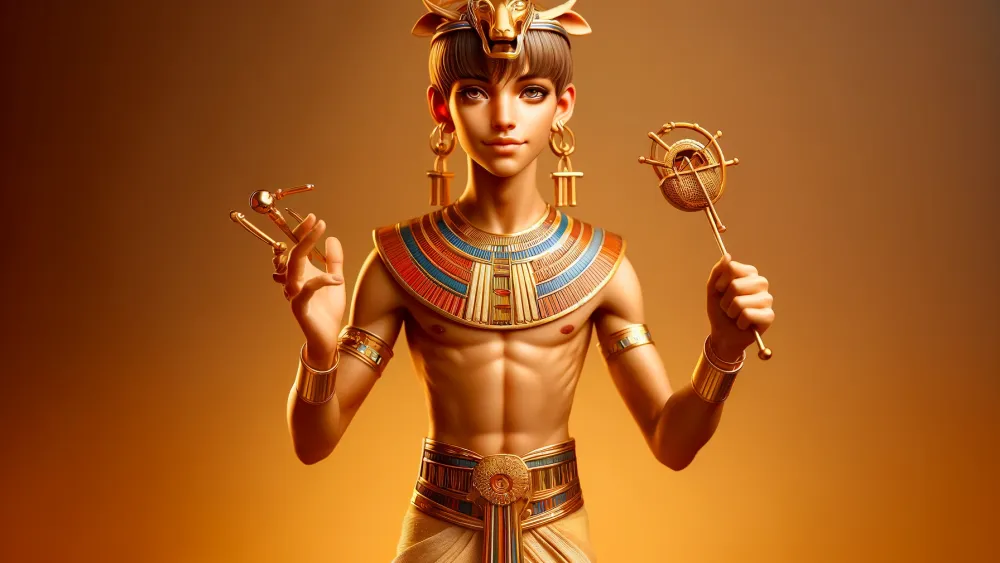
As for his divine duties, Ihy keeps the balance between joy and sorrow so that happiness wins out. These roles clearly show up in ancient Egyptian life. Music and dance play big parts in religious ceremonies, festivals, plus daily life. Temples have special spots for musical shows where priests play instruments like the sistrum to honor Ihy.
For instance, during the Festival of Hathor, people celebrate with music plus dance to get Ihy’s blessings. Furthermore, his influence reaches social gatherings and family parties where music is essential. Consequently, he is present at both grand events and everyday moments, making him central to ancient Egyptian culture.
The Symbolism of Ihy and the Sistrum
Ihy’s link to the sistrum (a musical instrument) holds deep meaning. The sistrum, used in religious ceremonies, stands for joy and divine music. When Ihy holds it, he shows his role as a bringer of happiness. In particular, the sistrum’s rattles make soothing sounds that please gods and chase away evil spirits. This makes Ihy not only a symbol of joy but also a protector.
Furthermore, since the sistrum looks like an ankh (a life symbol), it ties Ihy to eternal life. Aside from the sistrum, other symbols connect with Ihy too. He often wears a necklace of beads which means festivity and celebration. For instance, Ihy sometimes holds a lotus flower (a sign of rebirth) in his hand. This highlights his role in bringing joy.
Another common item is the menat (a special necklace) that stands for fertility plus protection. These symbols show Ihy’s many sides as god of music, joy, and safety. Symbols linked with Ihy:
- Sistrum: Stands for joy and divine music.
- Necklace of beads: Means festivity and celebration.
- Lotus flower: Signifies rebirth and purity.
- Menat: Represents fertility plus protection
Ihy’s connection to various symbols like the sistrum and lotus flower represents his multifaceted role as a god of music, joy, and safety.
Worship and Temples Dedicated to Ihy
Given that Ihy connects deeply to joy and music, it’s no surprise he has special places of worship. Let’s see where and how people honor him.
The Temple of Hathor at Dendera
The Temple of Hathor at Dendera is one of Egypt’s best-preserved temples. Built during the Ptolemaïc period, it honors Hathor, the goddess of love and music. The complex includes a main temple, a birth house (mammisi), and a sacred lake. In particular, the main temple has stunning reliefs that show various gods and goddesses.
The ceiling in the hypostyle hall shows astronomical scenes like the famous Dendera Zodiac. This place helps us understand ancient Egyptian religion. Ihy holds a special spot here as Hathor’s son. Priests honor him with music and dance using the sistrum to call his presence. For instance, rituals include playing the sistrum and singing hymns to celebrate Ihy’s joy-bringing role.
At the same time, the birth house (mammisi) highlights Ihy’s divine birth plus his link to renewal and life. Statues show Ihy as a young boy holding a sistrum, emphasizing his importance in ceremonies.
The Temple of Hathor at Dendera provides valuable information about ancient Egyptian religious practices and specifically emphasizes the significance of Ihy, Hathor’s son, through rituals and depictions.
The Mammisi: Birth Houses of Ihy
The mammisi, or birth houses, are special spots in Egyptian temples for the divine birth of gods like Ihy. These small chapels usually sit near the main temple and have detailed carvings and reliefs. For instance, the walls show scenes of the god’s birth and early life. They often depict Ihy as a young child with his mother, Hathor.
As a result, these images highlight how important divine lineage is and connect gods to humans. The mammisi acts as a place where the divine meets the mortal world. Rituals in the mammisi celebrate the god’s birth and ensure life continues smoothly. Priests perform these rituals with music, dance, and offerings. For example, they play the sistrum while chanting hymns to honor Ihy and ask for his blessings.
At the same time, offerings like food, drink, and flowers go on altars inside. These acts aim to please gods so they favor people. Ceremonies also reenact the god’s birth emphasizing renewal themes plus rebirth ideas.
The mammisi in Egyptian temples play a crucial role in connecting gods to humans through detailed carvings and rituals that honor divine lineage and seek blessings for a smooth life.
Musical Instruments and Festivities
Since Ihy loves music and joy, we should look at the instruments and celebrations that honor him. Let’s see how ancient Egyptians used music and dance in their rituals.
The Sacred Sistrum: An Integral Part of Ihy’s Representation
The sistrum is a special musical instrument in ancient Egypt. Made from metal or wood, it has a handle and a U-shaped frame with crossbars. When shaken, the crossbars make a jinging sound. For instance, the sistrum’s sound mimics the rustle of papyrus plants in the wind.
This instrument often appears in religious ceremonies and rituals because its design and sound aim to please gods and create a sacred vibe. Its construction makes it both durable and portable so it’s perfect for various uses. In particular, the sistrum plays an important role in worshipping Ihy. He is often shown holding one since he loves music and joy.

Priests use it to call on his presence during rituals by shaking it while chanting hymns or prayers. This act honors not only Ihy but also other deities like Hathor who are linked to this instrument. For example, during temple rituals priests shake the sistrum to ward off evil spirits plus bring blessings.
Consequently, it becomes essential for keeping spiritual harmony and invoking divine protection
Music and Dance in Ancient Egyptian Worship
Ancient Egyptian rituals use many musical instruments. These include the sistrum (a rattle-like instrument), the harp, the lute, and the lyre. Drums and clappers (simple percussion tools) also play big roles. For instance, priests shake the sistrum to make a jinging sound that pleases gods. Harps and lutes add melodies while drums and clappers give rhythm.
- Sistrum
- Harp
- Lute
- Lyre
- Drums
- Clappers
Dance and music hold special places in religious ceremonies.
Priests use them to honor gods or call on their presence. For example, during temple festivals, dancers perform moves that tell stories of gods. These dances often go with hymns or prayers so they engage people more. Music sets the tone plus pace for rituals helping focus minds better.
Ihy’s Depiction in Art and Literature
Since Ihy loves music and joy, his image shows up a lot in ancient art. Let’s see how artists and writers portray him.
Ihy in Ancient Egyptian Art
Artists often show Ihy as a young boy, sometimes naked, holding a sistrum (a musical instrument) in one hand. He usually has a sidelock of youth (a hairstyle for kids) and a finger to his mouth. For instance, in temple carvings and statues, Ihy stands next to his mother, Hathor, or sometimes his father, Horus.
These images highlight him as both a divine child and symbol of joy. The depictions of Ihy hold special meaning. They show how much music and joy matter in ancient Egypt. By showing Ihy with the sistrum, artists link him directly to musical rituals and celebrations. Furthermore, his youthful look symbolizes renewal plus life’s cycle.
Consequently, these artistic representations help us see how Egyptians value not only their gods but also joy, music, and eternal youth.
Literary References to Ihy
Ancient Egyptian texts and inscriptions often mention Ihy, especially in religious contexts. For instance, in the Pyramid Texts (a collection of ancient spells), people call on Ihy to bring joy and music to the afterlife. These texts describe him as a divine musician who plays the sistrum for the gods.
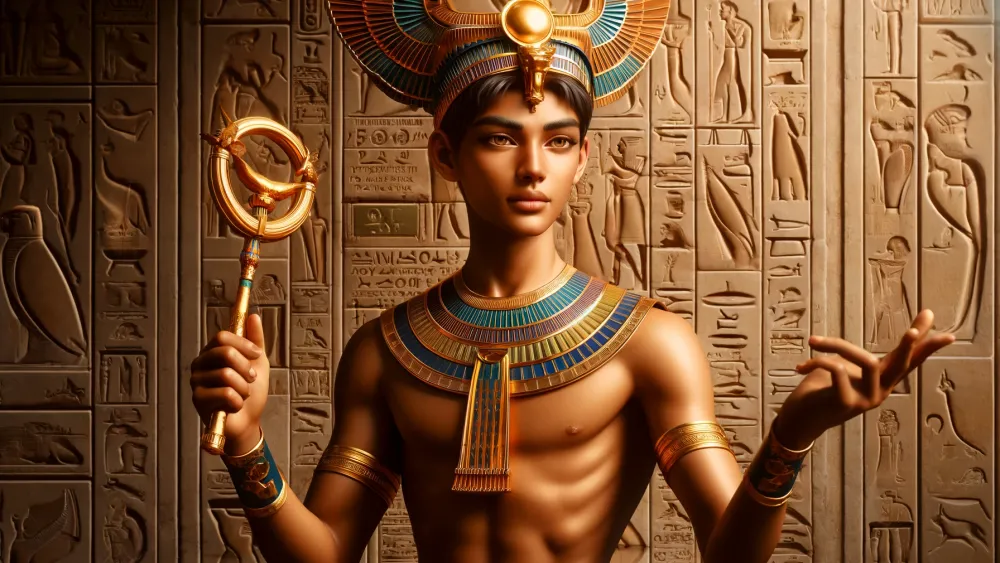
At the same time, temple writings at Dendera (a site dedicated to Hathor) frequently talk about Ihy. They highlight his role in various rituals and ceremonies. These writings often show him as a joyful figure who brings happiness. These references help us see how important Ihy is in worship. They show that he isn’t just a minor god but an important part of religious practices.
By mentioning him in spells and temple writings, these texts stress his role in bringing joy and music to sacred places. Furthermore, these literary sources give insights into how Egyptians view music and joy as gifts from the gods. Consequently, they help us understand the broader cultural importance of Ihy in ancient Egypt.
Ancient Egyptian texts and inscriptions emphasize the significance of Ihy in religious practices and the cultural importance of music and joy in ancient Egypt.
Pantheon of All the Egyptian Mythology Gods
Ancient Egyptian mythology has a rich mix of gods and goddesses. Each one has unique roles and stories. For instance, Ra is the sun god, while Ihy is the god of music and joy. These divine figures play crucial roles in daily life. As for a full list with all Egyptian gods, you can check out this list of all the Egyptian gods.
This resource gives detailed info on each deity. Consequently, it helps you understand their importance and how they fit into the broader tapestry of Egyptian mythology.
FAQs
1. How is Ihy depicted in ancient Egyptian art?
Ihy is depicted in ancient Egyptian art as a young child often holding a sistrum, symbolizing his role as the god of music and joy.
2. What is the significance of the sistrum in Ihy’s worship?
The significance of the sistrum in Ihy’s worship lies in its role as a sacred musical instrument that symbolizes joy and divine connection.
3. Are there any temples dedicated specifically to Ihy?
Temples dedicated specifically to Ihy are rare, but he was venerated within the Temple of Hathor at Dendera.
4. How did Ihy influence music and celebration in ancient Egypt?
Ihy influenced music and celebration in ancient Egypt by embodying the joyous and musical aspects of religious and social festivities.

